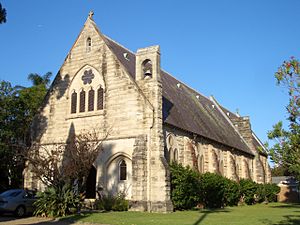Eastern broad-nosed bat facts for kids
Quick facts for kids Eastern broad-nosed bat |
|
|---|---|
| Conservation status | |
| Scientific classification | |
| Genus: |
Scotorepens
|
| Species: |
orion
|
| Synonyms | |
|
Scoteinus orion Troughton, 1937. |
|
The eastern broad-nosed bat (Scotorepens orion) is a type of vespertilionid bat. These bats are found only in Australia. They live east of the Great Dividing Range. Their home stretches from Rockhampton to Melbourne. A small group also lives on the Atherton Tablelands.
What Does It Look Like?
This bat is a medium-sized animal. Its forearm is about 32 to 39 millimeters long. That's roughly the length of a few paperclips. Its fur is a rich, dark brown on its back. The belly is a bit duller in color. However, the two colors don't stand out much.
Eastern broad-nosed bats often sleep in tree hollows. They have also been seen roosting in buildings. They sometimes share their sleeping spots. Other bats like the Chocolate Wattled bat might join them. Usually, a single baby bat is born. This happens in November or December.
Where Do They Live?
These bats live in eastern Australia. One place they have been seen is Wilson Reserve. This reserve is in Ivanhoe, Melbourne. It is about 10 kilometers northeast of the city center. The reserve is on the north bank of the Yarra River.
The Friends of Wilson Reserve group set up 20 timber roost boxes there. Gould's Wattled bats started using these boxes in 2005. The first Eastern broad-nosed bat appeared in January 2007. Since then, they have recorded this species 45 times. About 25 of these records happened after 2011. That's when they started putting wristbands on the bats.
They have banded 18 bats in total. Nine were male and nine were female. These bats are usually found alone or in pairs. In December 2014, two new females were found in one box. Both had young babies with them. One baby was bald and very new. The other was older, furry, and almost as big as its mother.
How Was It Discovered?
The Eastern broad-nosed bat was first described in 1937. This was done by a scientist named Ellis Troughton. He first called it Scoteinus orion. Later, in 1943, he created a new group for it. This group was called Scotorepens.
Troughton described a bat that lived in New South Wales. It was even found in city buildings. But no one had really studied it before. This was the first of four new species he found. He looked at old museum bats and new ones.
The first bats he described were found in a church. Workers from the Australian Museum were trying to remove bats from the All Saints Church. This church is in Hunters Hill, New South Wales. They found the first bat there. They later found a second one. Eleven more bats from the church were also sent to Troughton. Another bat that fell from a tree at Taronga Park was also sent to him.
See also
 In Spanish: Scotorepens orion para niños
In Spanish: Scotorepens orion para niños



